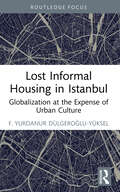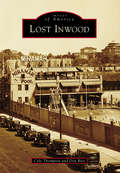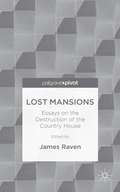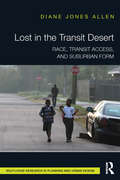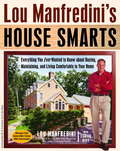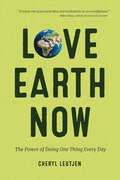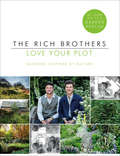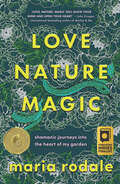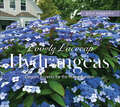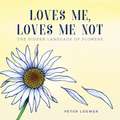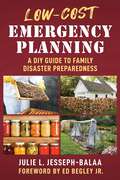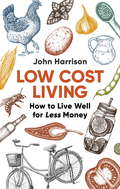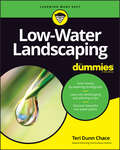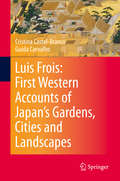- Table View
- List View
Lost Informal Housing in Istanbul: Globalization at the Expense of Urban Culture
by F. Yurdanur Dulgeroglu-YukselThe dynamics of globalization brought a radical change in megacities and tensions between the stakeholders and dwellers against top-down urban renewal policies. This unique book provides a worldview of multi-stakeholders in the urban housing market. With a longitudinal research approach, it paves the way for interdisciplinary researchers to critically assess the urban renewal projects and update such studies. The urban renewal processes are implemented without participation, and the book highlights field-based information for policymakers. The reader will find, with the information provided from the field, why participation is necessary for a sustainable urban development, why there are different types of urbanizations, and how it works under different conditions. Better understanding of the challenges of urban renewal processes in the world cities is intended with the focus on the changing informal settlements. Istanbul is a megacity, housing more than half of its dwellers in informal settlements. After many decades of self-upgrading and silently communicating with the local authorities, the informal sector had become adapted and maintained its living spaces. Unexpectedly, the end of the first decade of the 21st century marked a radical urban land valuation and international investments. Top-down interventions started with naming Istanbul the 2010 European Capital of Culture. Then came the Law of Urban Transformation, which meant the fast decline of squatter housing and the speedy loss of its cultural value of the mahalle spirit, place identity. The book will raise curiosity on why the time has come to change the perspectives about the informal urban sector.
Lost Inwood (Images of America)
by Cole Thompson Don RiceInwood, the northernmost neighborhood of Manhattan, has a rich yet little-known history. For centuries, the region remained practically unchanged--a quaint, country village known to early Dutch settlers as Tubby Hook. The subway's arrival in the early 1900s transformed the area, once scorned as "ten miles from a beefsteak," from farm to city virtually overnight. The same construction boom sparked an age of neighborhood self-discovery, when vestiges of the past--in the form of mastodon bones, arrowheads, colonial pottery, Revolutionary War cannonballs, and forgotten cemeteries--emerged from the earth. Waves of German, Irish, and Dominican immigrants subsequently produced a vibrant urban oasis with a big-city/small-town feel. Inwood has also been home to wealthy country estates, pre-integration sports arenas, and a lively waterfront culture. Famous residents have included NBA legend Kareem Abdul-Jabbar, Basketball Diaries author Jim Carroll, and Hamilton creator/star Lin-Manuel Miranda.
Lost Mansions: Essays on the Destruction of the Country House
by James RavenThis provocative volume stimulates debate about lost 'heritage' by examining the history of the hundreds of great houses demolished in Britain and Ireland in the twentieth century. Seven lively essays debate our understanding of what is meant by loss and how it relates to popular conceptions of the great house.
Lost in the Transit Desert: Race, Transit Access, and Suburban Form
by Diane Jones AllenIncreased redevelopment, the dismantling of public housing, and increasing housing costs are forcing a shift in migration of lower income and transit dependent populations to the suburbs. These suburbs are often missing basic transportation, and strategies to address this are lacking. This absence of public transit creates barriers to viable employment and accessibility to cultural networks, and plays a role in increasing social inequality. This book investigates how housing and transport policy have played their role in creating these "Transit Deserts," and what impact race has upon those likely to be affected. Diane Jones Allen uses research from New Orleans, Baltimore, and Chicago to explore the forces at work in these situations, as well as proposing potential solutions. Mapping, interviews, photographs, and narratives all come together to highlight the inequities and challenges in Transit Deserts, where a lack of access can make all journeys, such as to jobs, stores, or relatives, much more difficult. Alternatives to public transit abound, from traditional methods such as biking and carpooling to more culturally specific tactics, and are examined comprehensively. This is valuable reading for students and researchers interested in transport planning, urban planning, city infrastructure, and transport geography.
Lou Manfredini's House Smarts
by Lou ManfrediniLou Manfredini, aka Mr. Fix-It, is the trusted friend every homeowner wishes he or she had--someone who knows houses. In his fun, friendly, fully illustrated guide for both inexperienced and seasoned homeowners, he takes you through your entire house and around the yard, showing you how it all works and what to do when it doesn't. The result: You'll have a clear understanding of the systems that make up your house and gain the expert knowledge to proceed with any job, big or small--whether you're hiring a contractor or doing it yourself. Discover* How your house works: an anatomy lesson* The wonders of water--where it comes from and where it goes* Getting wired--the magic of electricity* Windows--ways to bring in the sunshine and keep out the drafts* The joys of being floored--good floor construction and maintenance* Wall power--it's not what's on them but what's in them that counts* Decorating secrets the pros don't like to sharePlus Lou Manfredini's sixty-minute home inspection, an essential tool list, and an ABC glossary of terms: from air duct to weather stripping!From the Trade Paperback edition.
Louisiana Herb Journal: Healing on Home Ground
by Corinne MartinIn a world of constant change and crisis, the relationship between humans and their environment has never been more vital. Louisiana Herb Journal invites readers into the world of medicinal herbs, introducing fifty herbs found in Louisiana, with details on identification, habitat, distribution, healing properties, and traditional uses, including instruction on popular preparation methods such as tinctures and teas. Interspersed with these practical details, herbalist Corinne Martin shares stories that foster a true connection between readers and the world around them, from tales of childhood cherry picking to harvest mishaps to folklife traditions passed down through the generations. Accessible to experienced and rookie herbalists alike, Louisiana Herb Journal offers a new way of looking at the natural world, getting to know one’s “home ground” through a lens of healing and participation.Family connections, an intimate knowledge of the surrounding lands and waters, strong community bonds, an irrepressible resilience, and a great capacity for celebrating life despite hardships are part and parcel of what it means to be from Louisiana. A celebration of the state and the cultures of those who live there, Louisiana Herb Journal reflects on the value of medicinal herbs in promoting personal healing and addressing current challenges to the state’s environmental and economic stability. Readers will gain a deeper recognition of the natural wealth Louisiana enjoys and the ways that our stewardship of wild plants can impact our personal health as well as the state’s ecological future.
Lovable Livable Home: How to Add Beauty, Get Organized, and Make Your House Work for You
by Sherry Petersik John PetersikThis New York Times bestselling book is packed with thoughtful advice and inspiring photos to help you create a home filled with beauty and meaning. In the three years since Sherry and John Petersik wrote their bestselling book Young House Love, they have bought a new house and had a new baby, and they have seen their design perspective evolve right along with their family. In their latest book, they’ve set out to prove that just because you have kids or pets doesn’t mean you’re sentenced to floors overrun with toys or furniture covered in plastic. Through never-before-seen makeovers in the Petersiks’ own house, doable DIY projects, and a gallery of other inspiring spaces, Lovable Livable Home shows how beautiful homes can be functional too.
Love Affairs with Houses
by Bunny Williams“Her commentary on the origins, allure, and challenges of each home reads like liner notes to a favorite album . . . she is in a class all her own.” —FlowerIn this story-filled monograph, Bunny Williams presents new work through 15 houses she has decorated and loved. She tells the tale of each “affair,” tracing the style of the spaces, what drew her to the projects, and her approach to decor that evolves with the lives of her clients. She offers personal secrets for choosing classics—and for decorating with flexible pieces that can play more than one role in a design scheme. Along the way, she offers many amazingly chic, but always comfortable, residences whose interiors she has designed during the latest phase of her astounding career. As Bunny tells it, “The best pieces have the best stories,” and in this book, she shows readers a fresh collection of projects that demonstrate just that. “A must-have addition to any interior design enthusiast’s library.” —The Glam Pad
Love Coming Home: Transform Your Environment. Transform Your Life
by Jennifer AdamsLove Coming Home is a guide for readers to envision the home of their dreams and manifest them where they live right now no matter what their budget or living situation.Home is your base. Home is your sanctuary. It&’s where your best life begins. This friendly guide will give you the tools and knowledge, and empower you to make wherever you live—be it rented, owned, or shared—a place where you will absolutely love coming home to. No matter how much or how little someone has at a given moment, we often hold the belief that our actual dream home will be a place we will eventually move to down the road once we&’ve saved enough and worked hard enough to achieve it. We are all striving to discover that perfect place and rarely see the potential in the place we are living in right now. Jennifer Adams, designer and founder of the international home décor company Home by Jennifer Adams®, shares her insider secrets of how you don&’t have to wait. In Love Coming Home, Jennifer combines her professional designer&’s tool kit of proven tips and resources with her inspirational coaching experience, motivating and empowering you to turn your ideas of a dream home into reality by: demystifying the practical and powerful visualization tool, Vision Boards showing you simple steps to define, refine, and align your home projects and ideas into manageable goals inspiring you to let go of restrictions and take action with confidence sharing her top eleven designer&’s secrets, and so much more Jennifer&’s step-by-step, room-by-room, guidance will help you create a welcoming and functioning space that expresses your unique individuality throughout even the smallest to largest of floor plans. Your dwelling can become an environment that supports and inspires you, to be your perfect sanctuary, because home is where your best life begins!
Love Earth Now: The Power of Doing One Thing Every Day
by Cheryl LeutjenHow to live sustainably in an unsustainable society—and not let the world discourage your spirit. Do you find yourself wondering what on Earth you can do about the very serious environmental challenges we face on our planet today? Do you worry there’s nothing any one person can do that will make a difference? Most people say that they would like to do something to make the world a better place, but they just don’t believe they have the time, energy, money, or power to make a real difference. Love Earth Now invites us to explore our own thoughts and feelings about the challenge, and to check in with internal guidance about the waste and negative environmental impacts we see on a daily basis. While most of us can’t stop the Arctic icepack from melting, we can decide to make better choices like avoiding excessive packaging with our purchases, walking more and driving less, planting organic veggies in the front yard instead of a water-wasting lawn, and even going as green as possible at work and at home. Does your office lack a recycling and composting program? Do the research and start one yourself! Each chapter concludes with a “Diving In” section, a simple and immediate exercise, much like a guided meditation, to prompt us toward our own sustainable solutions. By practicing eco-mindfulness, we can discover that one thing we can do to make a difference today and for all our tomorrows. This is not only a source of inspiration but a sourcebook of direct actions—large and small—we can all take to ensure our children and their children’s children have a healthy future on this planet. Drawing from her experiences as an engineering geologist, environmental law attorney, small shop owner, and mindfulness practitioner, Cheryl Leutjen also reminds us about the importance of simplicity—and how all our possessions and the constant shopping for more are no better for us than they are for the planet itself, contributing to landfills and a tech-tethered society that is increasingly isolated. Both helpful and hopeful, Love Earth Now is brimming with creative suggestions that will get us closer to a sustainable lifestyle, one day at a time.
Love Your Creative Space: A Visual Guide to Creating an Inspiring & Organized Studio Without Breaking the Bank
by Lilo BowmanA budget-friendly guide for needleworkers, quilters, and crafters to help you design the best workspace to let your creativity flow.Does your creative den leave you feeling overwhelmed or uninspired? Energize your crafting space with jazzy ideas for organization and accessibility! With over one hundred and fifty photos, this lookbook offers an endless visual parade of ideas to help your studio reach its full potential. Smart storage solutions, furniture, and accessories can help quilters, needle artists, knitters, and crafters keep their creativity on track! Whether you’re undergoing a radical reinvention or looking for tiny tweaks, you’ll finally be able to plan and organize your projects in a workspace that works for you.Inspired workspaces! Get a sneak peek inside creative studios of all sizes, designed on budgets large and smallKeep creativity flowing and stay organized with smart systems in placeMake your space accessible! Pursue your passion in spite of physical challenges
Love Your Home Again: Organize Your Space and Uncover the Home of Your Dreams
by Ann Lightfoot Kate PawlowskiA Compassionate and Practical Guide to Reimagining the Home of Your Dreams In Love Your Home Again, Ann Lightfoot and Kate Pawlowski—organizing experts and the mother-daughter duo behind Done & Done Home—ask questions that take into account who you are and how you actually live to help resolve the issues behind the excess and create lasting solutions to keep your home running smoothly. Sharing their tried-and-true systems of decluttering, organizing, and maintaining, along with real client stories, Lightfoot and Pawlowski teach you how to manage your home with their signature "good humor and refreshing lack of dogma" (the New York Times). Inside you'll find: Gentle guidance on things like handling sentimental items, embracing quality over quantity, and cutting down on waste Helpful tips for making your daily life easier, from meal-prepping to creating routines Organization methods for every room, small space strategies, and so much more You'll be amazed at the time, money, and energy you'll save—all better spent enjoying your space. Get ready to love your home again. FOR READERS OF: The Home Edit, Beautifully Organized, Simply Living Well, and Real Life Organizing RISING STAR AUTHORS: Ann and Kate are celebrities in the organization world. They are frequently asked to comment on home organizing, staging, and decluttering topics, with recent clips in Women's Day, the New York Times, People, Apartment Therapy, Bravo, CNN, and more. Their celebrity clients include Jenna Fischer, Christina Anstead, and many Real Housewives. FOR FANS OF HGTV: For readers who are obsessed with home makeover shows, this is the book for you. HGTV fans will be delighted to learn that they can design their own dream home through the power of organizing. A DIY PROJECT FOR EVERYONE AT HOME, WHICH IS . . . EVERYONE: This book is for the countless people working from their dining room table by day and watching home makeover shows at night. Love Your Home Again will show how you can rethink your own space, working with what you have. Perfect for: New homeowners Parents who want to declutter, boomers who want to downsize and/or stage a space HGTV fans who could watch home makeover shows for hours Young adults and millennials who love organizing
Love Your Plot: Gardens Inspired by Nature: tips and tricks to transform your garden into a perfect paradise
by David Rich Harry RichA full-colour and beautifully illustrated guide into transforming your existing garden or plot of land into a modern, visually-stunning - but also easily achieved and maintained - space. Including full-colour images and tips and tricks from gardening experts and Chelsea Flower Show Gold Medal winners Harry and David Rich as well as suggestions tailored to various garden types, this is a must-read for anyone wanting that little bit of paradise to escape to at home...'Full of creativity and good ideas... plenty here to whet the appetite of an aspiring garden designer' -- Gardens Illustrated'Love Your Plot is a book to read right through and then dip into again to bring a particular idea or method of working back into focus.' -- Garden Design Journal'Very inspiring' -- ***** Reader review'This book is a joy to own, beautifully written and illustrated. It's crammed with information, easy to read and fantastic inspiration' -- ***** Reader review'Awesome book. Clear and easy to understand with lots of useful tips' -- ***** Reader review'Best book ever for any garden designer - an excellent read' -- ***** Reader review'A gold mine of garden design wisdom' -- ***** Reader review*****************************************************************************************************Fusing conceptual garden design with the beauty of the natural landscape, twice Chelsea Flower Show Gold Medal winners and stars of BBC's Garden Rescue Harry and David Rich are here to show you how you can transform your outdoor space into a beautiful Eden, no matter what plot you have.In Love Your Plot Harry and David set out to help you transform your outdoor space into an inspiration green haven by making nature work for you. Fusing different outdoor elements, such as coastal and woodland landscapes, alongside key design principles, they will show you how to create a modern, practical and visually stunning outdoor space that will awe and inspire - and that is crucially easy to maintain.Complete with practical tips, unique sketches and designs, planting suggestions and stunning full-colour visuals, Love Your Plot will have you reaching for the spade and wellies in no time at all to create your own Eden, no matter what plot you've got.
Love the House You're In
by Paige Rien"From the introduction: This is a design book about improving your house that doesn't contain a single photograph. I am not showing you my work and telling you to copy it or emulate it or be inspired by it. There are no before and after shots here, no big reveals, no secret tips, no eye candy. This book is all about what makes you smile and feel good. This book is also about what your house looks like now, and working with that. This book is full of ideas, inquiries, and insights that will get you thinking and moving. I'm so excited to help you fill in the giant blank between oI hate my house! I'm losto and oI love this spaceuit's so me. o"
Love, Nature, Magic: Shamanic Journeys into the Heart of My Garden
by Maria RodaleA Wall Street Journal &“Best Read&”2024 Nautilus Book Award Gold Medal Winner: Nature & AnimalsJoin author, activist, and garden expert Maria Rodale as she reflects on her surprising conversations with the spirits of the familiar plants and animals around us—and the knowledge they share with us.In Love, Nature, Magic, organic advocate and former CEO of a global health and wellness company Maria Rodale combines her love of nature and gardening with her experience in shamanic journeying, embarking on an epic adventure to learn from plants, animals, and insects—including some of the most misunderstood beings in nature. Maria asks them their purpose and listens as they show and declare what they want us humans to know. From Thistles to Snakes, Poison Ivy to Mosquitoes, these nature beings convey messages that are relevant to every human, showing us how to live in balance and harmony on this Earth.Through journeys filled with surprises, humor, and foibles, follow Maria&’s evolution from resenting to accepting—and even falling in love with—our most difficult neighbors (including human ones).Maria&’s journeys include conversations with: Mugwort • Vulture • Bat • Rabbit • Lanternfly • Lightning Bug • Osage Orange • Deer • Paper Wasp • Dandelion • Tick • Groundhog • Milkweed • And more!Throughout, Maria shares an essential truth that resonates across her shamanic explorations: We first must heal our own hearts, for only then can we truly love others and begin to heal planet Earth.&“Love, Nature, Magic will blow your mind and open your heart.&”—John Grogan, author of Marley & Me&“Anyone interested in plant intelligence, and in journeying WITHOUT plant medicines, will want to read this new book.&”—Michael Pollan, author of This is Your Mind on Plants (via X)&“Maria Rodale has written a book for anyone and everyone who loves nature, the garden, and the planet. The book we didn&’t know we needed, at the time we needed it most. For comfort, for solace, for the heart and the mind.&”—Bette Midler (via X)&“Let&’s hear it for women intent on conquering new worlds—especially on the astral plane . . . [This] is a fascinating book . . . Rodale bares her soul. . . This is a journey into her heart.&”—Dominique Browning, Wall Street Journal
Loved Clothes Last: How the Joy of Rewearing and Repairing Your Clothes Can Be a Revolutionary Act
by Orsola de Castro'It's important that everyone with an interest in fashion reads this book so we can live on a healthier planet' Arizona Muse 'The most timely book you'll read this year' India Knight* * * * * Running out of space for the clothes you can't stop buying? Curious about how you can make a difference to the environmental challenges our planet faces? Join Orsola's care revolution and learn to make the clothes you love, last longer.This book will equip you with a myriad of ways to mend, rewear and breathe new life into your wardrobe to achieve a more sustainable lifestyle. By teaching you to scrutinise your shopping habits and make sustainable purchases, she will inspire you to buy better, care more and reduce your carbon footprint by simply making your loved clothes last longer.Following Orsola's practical tips to lavish care and attention on the clothes you already own will not only have a positive environmental impact, but will be personally rewarding too: hand wash, steam and spot clean your clothes, air dry instead of tumble drying, or revive your clothes by sewing or crocheting.Fast fashion leaves behind a trail of human and environmental exploitation. Our wardrobes don't have to be the finish line; they can be a starting point. We can all care, repair and rewear. Do you accept the challenge?* * * * *'An incredibly thoughtful, must-read guide' Kenya Hunt'A must read for anyone who wants to understand the fashion industry as an outsider and wants direction as to where we go next' Aja Barber
Lovely Lacecap Hydrangeas: Elegant Accents for the Home Garden
by Joan HarrisonLacecaps are the elegant form of the Hydrangea macrophylla species, popular for their sturdy, long-lasting blooms that appear delicate. They excel when massed in swaths of color, blended with companion plants, and thrive in containers and unheated spaces. Lovely Lacecap Hydrangeas: Elegant Accents for the Home Garden offers a detailed look at the best lacecap varieties, helping gardeners select plants to enhance their displays. Chapters cover • lacecap varieties, • flower color, • plant size and selection tips, • life cycle and care, • landscaping to maximize the visual impact of lacecaps, • successfully planting and caring for lacecaps, and • bringing lacecaps indoors for use in both fresh and dried flower arrangement.With over 200 color photos showcasing labeled varieties, the book provides comprehensive information on this popular segment of the hydrangea market.
Loves Me, Loves Me Not: The Hidden Language of Flowers
by Peter Loewer“A single flow’r he sent me, since we met. All tenderly his messenger he chose; Deep-hearted, pure, with scented dew still wet—One perfect rose.” —Dorothy Parker Welcome to the mysterious and sometimes scandalous world of the language of flowers. Since the days of Queen Victoria (and earlier the harems of the Middle East) flowers have allowed lovers and friends to express themselves without saying a word. In Loves Me, Loves Me Not, author and illustrator Peter Loewer explores the fascinating history of floral messages. In this book you'll find intriguing plant lore, unexpected historical connections, or simply an opportunity to connect with a beloved in a unique way. Confess unrequited love with a daffodil. Show happiness with primroses. Wish someone luck with a four-leaf clover. Make your declaration of love not with a rose, but with a tulip! With intriguing stories and stunning full-color illustrations, Loves Me, Loves Me Not, introduces you to flowers that have been conveying message for centuries. As Loewer says: "The language of flowers is a delightful idea. In the world of cell phones and mass communications, sending a simple bouquet that tells a tale of love and affection seems to be a great idea whose time has come again."
Low Waste Kitchen: Radical Recipes for Sustainable Living
by Alessandro VitaleWelcome to Alessandro Vitale a.k.a SpicyMoutstache’s world, where he’s on a determined mission to reduce waste in your kitchen. Everyone wants to live more sustainably, but it's hard to know where to start. With all those small steps towards zero-waste will come to light. Through 100 step-by-step low-waste recipes, Alessandro Vitale (Spicy Moustache) shows that everyone can make small changes for a big environmental impact. Driven by a desire for a more sustainable world, Alessandro’s success has been his plant-based 60 second videos on maximizing flavor and making the most of different fruit and vegetables. Now, Spicy brings his straightforward approach to the page, with step-by-step low- and zero-waste recipes for delicious plant-based meals and snacks, along with a handful of household remedies, cosmetics, and useful tips on food storage, shopping, and more – everything you need to reduce waste in your kitchen and home.
Low-Cost Emergency Planning: A DIY Guide to Family Disaster Preparedness
by Julie L. Jesseph-BalaaA Guide to Family Emergency Readiness That Doesn&’t Break the Bank It is easy to think that you need a small fortune to make plans and stock up for emergency situations. But this book offers an alternative: that families don&’t need to spend their entire savings to be prepared. A solid plan––combined with common sense habits––can use your family&’s day-to-day lifestyle choices to enhance your survival quotient. In Low-Cost Emergency Planning, learn how to develop practices and repurpose everyday household discards to improve your family&’s readiness for natural and human-made disasters. This book offers advice on the basics, from water and food to hygiene and energy alternatives, with full-color photos and clear instructions. By focusing on sustainable habits and DIY resources for basic household necessities, families can be prepared for anything.
Low-Cost Living 2nd Edition: How to Live Well for Less Money
by John HarrisonWhen economic conditions are tough, we all need to watch our spending. John Harrison's simple, tried and tested methods will help you to enjoy a better standard of living while saving money and helping the environment.Discover the benefits of growing your own fruit and vegetables, raising chickens, making butter, cheese and bread, and brewing your own beer.Save energy, save on your bills.Harvest food for free and avoid waste.Play the supermarkets at their own game and get the best deals.See how to recycle, re-use, make do and mend.Find out if solar power is right for you and whether wind power makes domestic sense.
Low-Water Landscaping For Dummies
by Teri Dunn ChaceSay goodbye to water-guzzling lawns and create beautiful, landscape designs Low-Water Landscaping For Dummies will teach you to preserve one of our most critical natural resources while simultaneously maximizing your curb appeal. Ditch wasteful, inefficient irrigation methods like sprinkler systems and learn how to embrace designs that save water. This book guides you through different styles of landscaping, introduces you to uniquely drought-tolerant plants, and provides solutions for even the trickiest terrains. You can break the cycle of constant watering, without sacrificing the relaxing atmosphere and aesthetic appeal of your outdoor space. Learn how it’s possible to have vibrant, unique, gorgeous landscapes that incorporate grasses, perennials, shrubs, trees, groundcovers, and succulents without wasting hundreds of gallons of water each day. Packed with useful tips, achievable plans, and easy-to-understand instructions, Low-Water Landscaping For Dummies is the only resource eco-conscious gardeners need to design, plant, and enjoy the landscape of their dreams. Design a landscape that fits your space and budget Discover beautiful, drought-tolerant plants Get regional tips to ensure success Troubleshoot common gardening problemsIf you want to protect the environment, save money on water bills, and learn more about drought-tolerant plants, this is the friendly Dummies guide for you.
Lucid Food: Cooking for an Eco-conscious Life
by Louisa ShafiaGreen Your Cuisine with Earth-Friendly Food Choices. With organic and seasonal cooking principles becoming ingrained in today's kitchens, and new buzzwords including locavore and CSA steadily gaining traction, how do we integrate food politics into daily life in ways that are convenient, affordable, and delicious? Lucid Food offers more than eighty-five healthy, eco-oriented recipes based on conscientious yet practical environmental ideals. Sustainable chef and caterer Louisa Shafia demystifies contemporary food issues for the home cook and presents simple, seasonal dishes that follow nature's cycles, such as Baby Artichokes with Fresh Chervil, Apricot Shortcake with Lavender Whipped Cream, and Roasted Tomato and Goat Cheese Soup. Her empowering advice includes how to source animal products ethically and responsibly, support local food growers, and reduce one's carbon footprint through urban gardening, preserving, composting, and more. This cookbook celebrates the pleasures of savoring home-prepared meals that are healthful, honest, pure, additive-free, and transparently made, from the source to the table.
Luis Frois: First Western Accounts of Japan's Gardens, Cities and Landscapes
by Cristina Castel-Branco Guida CarvalhoThis book focuses on Luis Frois, a 16th-century Portuguese Jesuit and chronicler, who recorded his impressions of Japanese gardens, cities and building practices, tea-drinking rituals, Japan’s unification efforts, cultural traditions, and the many differences between Europe and Japan in remarkable manuscripts almost lost to time. This research also draws on other Portuguese descriptions from contemporary sources spanning the years 1543 – 1597, later validated by Japanese history and iconography. Importantly, explorer Jorge Alvares recorded his experiences of discovery, prompting St. Francis Xavier to visit Japan in 1549, thus ushering in the “Christian Century” in Japan.During this long period of accord and reciprocal curiosity, the Portuguese wrote in excess of 1500 pages of letters to European Jesuits that detail their impressions of the island nation—not to mention their observations of powerful public figures such as Oda Nobunaga, Toyotomi Hideyoshi, and Sen no Rikyu. In addition to examining these letters, the authors translated and researched early descriptions of 23 gardens in Kyoto and Nara and 9 important cities—later visited by the authors, sketched, photographed and compared with the imagery painted on 16th-century Japanese screens.However, the data gathered for this project was found mainly within five large volumes of Frois’ História do Japão (2500 pages) and his Treaty on Contradictions—two incomparable anthropological works that were unpublished until the mid-20th century for reasons detailed herein. His volumes continue to be explored for their insightful observations of places, cultural practices, and the formidable historical figures with whom he interacted.Thus, this book examines the world’s first globalization efforts that resulted in profitable commerce, the introduction of Portuguese firearms that changed Japan’s history, scientific advances, religious expansion, and many artistic exchanges that have endured the centuries.
Lulu Powers Food to Flowers: Simple, Stylish Food for Easy Entertaining
by Laura Holmes Haddad Lulu PowersFrom Lulu Powers, one of Los Angeles’s premier caterers and event planners, comes a lively, lushly photographed, full-color cookbook featuring 175 recipes and inspired party-planning tips. Lulu Powers Food to Flowers offers simple, stylish food for easy entertaining—invaluable steps to the perfect party or gathering, from a Coffee and Newspaper Party to a Retro Game Night to a Big City Cocktail Party.
